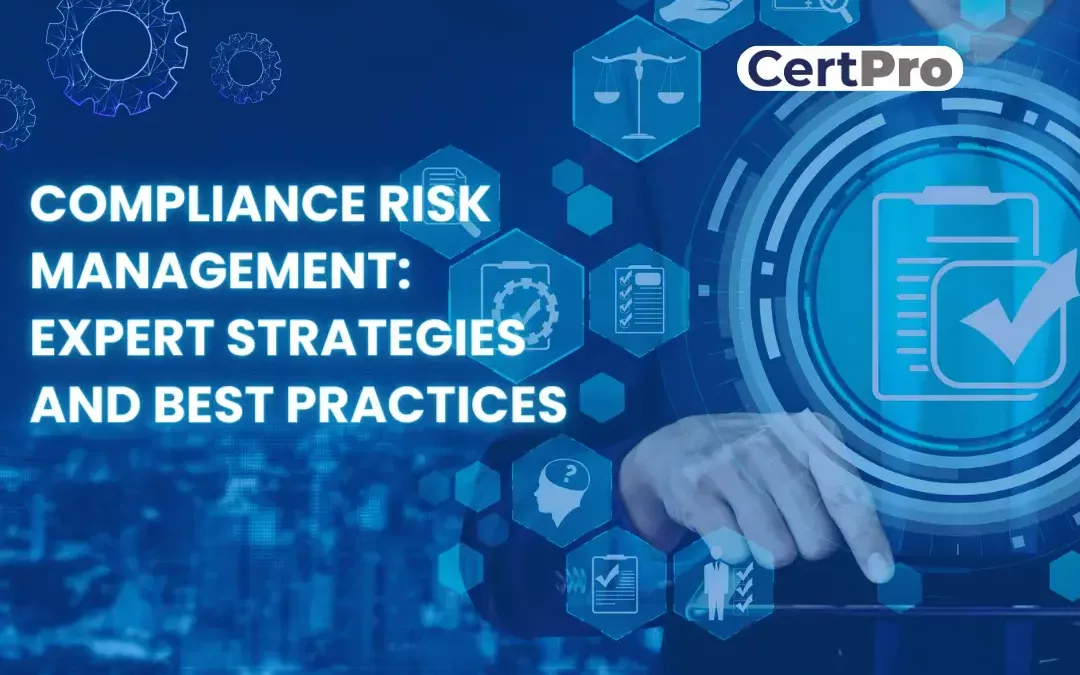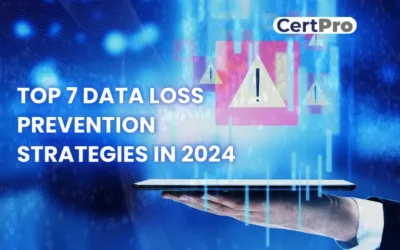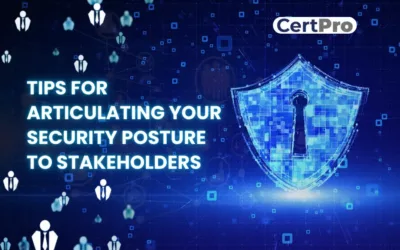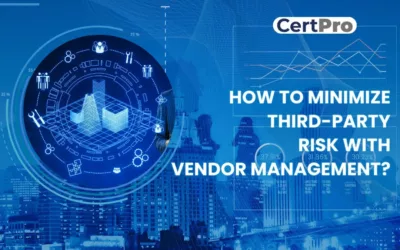Compliance risk considers the organization’s potential legal, material, and financial losses due to compliance failure. Thus, compliance risk is known as integrity risk. Organizations of all sizes are exposed to compliance risk. Hence, compliance failure results in reputational losses and shattered business growth. Compliance risk management is assessing and monitoring the risks of your organization’s compliance with industry standards and regulations. In this regard, your internal controls asses to ensure the effectiveness. The main aim of the process is to recognize the gaps in controls. Therefore, implement the necessary remediation to keep your organization safe and secure.
This blog will discuss the compliance risk management process and why it is crucial for your organization. Furthermore, try to recognize the steps of implementing compliance risk management. In addition, discuss the differences between risk and compliance risk management.
TYPES OF COMPLIANCE RISK FOR YOUR ORGANIZATION
STEPS OF COMPLIANCE RISK MANAGEMENT
POTENTIAL RISKS OF NON-COMPLIANCE FOR ORGANIZATIONS
ADVANCED TECHNOLOGIES IN COMPLIANCE RISK MANAGEMENT
IMPROVEMENT OF COMPLIANCE RISK MANAGEMENT SOFTWARE
COMPLIANCE RISK MANAGEMENT VS RISK MANAGEMENT
COMPLIANCE RISK MANAGEMENT WITH CERTPRO
TYPES OF COMPLIANCE RISK FOR YOUR ORGANIZATION
Your organization might face the following types of compliance risks:
- Illegal Practices within Organizations: Organizations must have legal compliance. It ensures that the organization and operational processes are following industry-specific regulations. Therefore, the illegal practice of an organization’s rules increases the risk of unlawful practice.
- Security Violations and Data Breaches: Data privacy is a prime concern if your organization handles sensitive data. Therefore, organizations need to procure appropriate measures to secure the data and prevent data breaches. However, weak controls can risk data violation.
- Environmental Concerns and Hazards: Such compliance risk indicates ecological damage due to the organization’s procedure. Consequently, if your organization directly or indirectly influences the environment and creates hazards, it enhances compliance risks.
- Dispute in Operational Process: An organization must have documented procedures regarding the standard operation process. Therefore, negligence or gaps in this regard increase risks of compliance.
- Safety in the Workplace: Organizations must have specific employee health and safety protocols. Thus, disagreements with the laws can lead to non-compliance.
STEPS OF COMPLIANCE RISK MANAGEMENT
Compliance risk management requires the following steps for implementation:
Recognizing the Organization’s Position: Identifying your organization’s external and internal operational processes is essential. It helps understand the organization’s policies, regulations, operational processes, and complexity. On the other hand, it will guide you regarding your regulatory requirements and help in implementation.
Conduct Risk Assessment: It helps recognize the efficacy of compliance regulations. Therefore, a risk matrix assists you in identifying the impact and severity of risks on your organization. The primary consideration of risk assessment is assessing threats and suggesting remedies.
Recognizing the Gaps: It is essential to the compliance risk management process. It assesses control gaps and enables organizations to identify areas of non-compliance. You will understand that your internal policies regarding industry standards fall short. In addition, it categorizes the risks and develops an action plan to fix the non-compliance.
Create Policies and Procedures: Execute new policies and procedures after determining the gaps in compliance. Once you recognize the gaps in regulations, implement policies and processes to ensure compliance. Therefore, a tactical mitigation plan should be executed to reduce compliance risk. Furthermore, the organization needs to organize a training program for their employees. It will inform them of new or upgraded compliance regulations.
Execute the Controls: Finding the gaps and recognizing the non-compliance is not the end of the scope. The organization must organize employee training programs and improve the monitoring system. Therefore, conducting regular audits is also essential. Thus, the measures enhance the compliance and avoid the risk of non-compliance.
Compliance Report: Compliance risk management requires continuous monitoring and tracking of progress. It will be considered a documented report on compliance objectives and their effectiveness in the future. Organizations will understand the impact of recommendations on maintaining compliance. In addition, your organization must have a compliance risk management framework. It provides confidence regarding compliance and avoids liabilities.
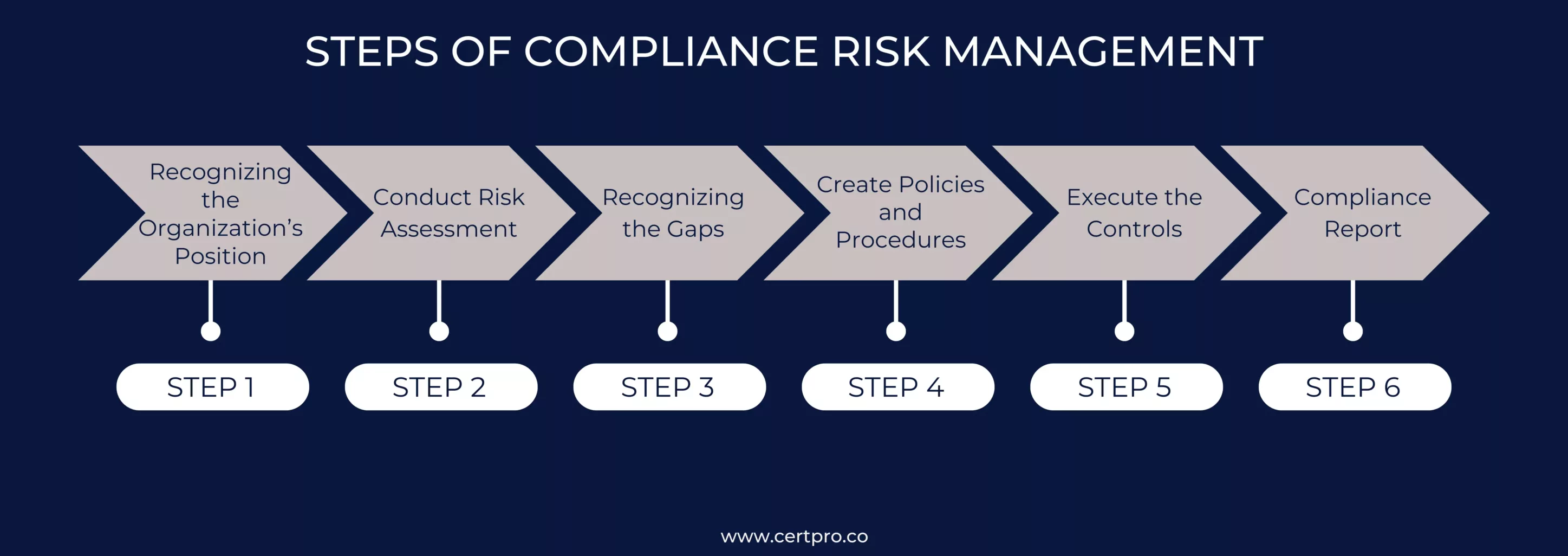
POTENTIAL RISKS OF NON-COMPLIANCE FOR ORGANIZATIONS
What will happen if your organization violates the compliance rules and regulations? Such failures can bring penalties and consequences. Therefore, the penalty depends on the industry structure and degree of violations. However, some expected consequences of no-compliance are listed below:
Financial Penalties: The most common non-compliance results in monetary penalties. Therefore, federal laws and regulations implement hefty fines for non-compliance. Your organization must appoint lawyers, external auditors, investigators, and advisers to resolve non-compliance issues despite the penalties. Hence, the process needs extra budget allocation to continue the rectification process. Thus, it is advisable to maintain and monitor your organization’s compliance to avoid the financial burden.
Reputational Damage: In everyday newspapers and digital media, giant companies’ non-compliance is covered. The modern era has the sophistication to explore the hidden truth. It harms reputation and business. Subsequently, the loss of corporate reputation can ruin the company’s market and business growth. At the same time, unhappy clients or employees might raise complaints. As an organization, you will surely try to avoid such mishaps. Furthermore, large markets can face the consequences, but not for small- and medium-scale businesses.
Blocked Access to Supply Chain: In the supply chain industry, non-compliance can shut down the business. Suppose your organization transports goods from one country to another. Therefore, non-compliance with documentation or import taxes can stop the shipping process. Thus, the whole supply chain management system is affected. Furthermore, the process distributors, suppliers, customers, and partners stop working. Your organization might face difficulties in scaling and continuing the business. Such businesses should maintain compliance to avoid risks.
ADVANCED TECHNOLOGIES IN COMPLIANCE RISK MANAGEMENT
Technological advancement is expected in today’s dynamic world. Therefore, the software helps avoid human errors. The tool can help you to assess the risk and mitigate the risk of non-compliance in your organization. In addition, it ensures that all ethical standards and regulations are well maintained. Similarly, it works as a centralized tracking platform and manages the regulatory compliance process. Furthermore, such software can help your business to align with ethical and legal practices. The most significant benefit of the tool is that it prevents human error and makes the system more effective and reliable. In this respect, the software can reduce the auditing time and avoid the risk of error. Other benefits of the software are:
Scrutinizing for Regulatory Changes: The primary function of software related to continuous scanning and updates on industry-specific regulations. Thus, the software automatically notifies the organizations regarding the emerging policies that must be incorporated.
Alerting Stakeholders: The software informed the stakeholders about upcoming audits and required actions for compliance. Thus, it ensures that everyone is responsive and alert.
Generating Compliance Reports: The software’s positive input is to create a detailed compliance report. It addresses the gaps in adhering to compliance and minimizes the errors in reporting.
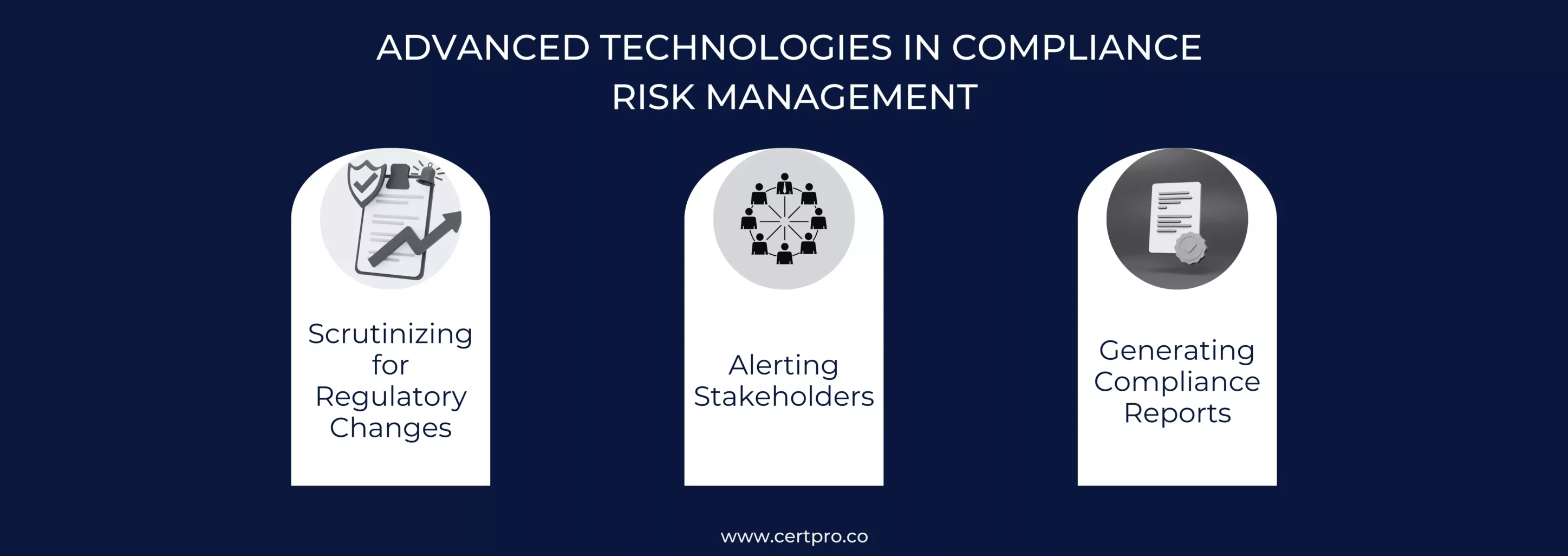
IMPROVEMENT OF COMPLIANCE RISK MANAGEMENT SOFTWARE
The software aggressively incorporates advanced technologies to increase its capabilities. A few aspects are discussed here:
- Incorporation of Artificial Intelligence: AI can make complex processes into simple ones. Therefore, it helps assess the compliance requirement and suggests adequate action to close the gaps.
- Advancement of Natural Language Processing (NLP): NLP enables language translation in regulatory concerns. Moreover, it assists in identifying relevant changes that benefit the organization.
- Inclusion of Blockchain Technology: Incorporating blockchain technology creates immutable records of actions. Therefore, it assures the audibility and integrity of documents related to compliance.
COMPLIANCE RISK MANAGEMENT VS RISK MANAGEMENT
Compliance risk management and risk management are different ideas that need further discussion. Thus, compliance risk management identifies, evaluates, and manages non-compliance risks with industry regulations. The primary objective of the process is to improve the organization’s regulatory requirements. On the other hand, risk management involves managing and detecting risks and mitigating the risks related to operational, strategic, and financial actions.
Compliance risk management ensures that the organization follows and adheres to internal policies. The process works towards eliminating regulatory infractions and penalties. In addition, the method improves reputation and business. However, risk management focuses on finding and mitigating risks threatening the organizations. It can be related to compliance or not, but risk management considers the whole. The compliance risk management framework considers the compliance risks of an organization. It monitors the compliance rules and regulations. In contrast, risk management uses a broader framework that recognizes the risk and manages the risk for data security.
Lastly, compliance risk management concentrates on reducing non-compliance-related issues within organizations. The main focus is adhering to rules and policies and avoiding hazards and penalties. However, risk management considers various risks related to strategy, cyber, and operational threats. Thus, it helps ensure the organization’s sustainability.
COMPLIANCE RISK MANAGEMENT WITH CERTPRO
No business wants to face the consequences of non-compliance with regulations and rules. Therefore, implementing the framework can help streamline the evaluation and adherence process. In addition, continuous monitoring is required as emerging new laws and regulations are expected. The monitoring process helps analyze and rectify the factors of concern. It reduces the risk of penalties and reputational damages. However, the monitoring process is complicated and time-consuming. Therefore, you can get help from experts like CertPro. We assure you quality services with expert recommendations and suggestions. Our skilled professionals will help you adhere to industry-specific compliance. We help you to find the gaps in existing rules. CertPro can assist your organization’s growth by implementing appropriate regulations.
FAQ
What are the Features of Compliance Risk Management Software?
Compliance risk management software has multiple features, including risk assessment tools, document management, reporting, and auditing management. Its primary aim is to advance and simplify the process.
How Compliance Risk Management Software Can Benefit Your Organization
It reduces auditing expenses and improves the risk assessment process. Furthermore, it avoids human error in reporting.
What is Governance, Risk, & Compliance?
GRC is a comprehensive and integrated framework. It monitors the organization’s activity and assesses whether compliance is maintained.
What are the components of compliance risk management?
Compliance risk management includes exposure, risk quality, and likelihood quantity.
What is the difference between proactive and reactive compliance risk management?
Proactive compliance risk management assesses potential risks and informs about them. However, reactive compliance risk management responds to an incident after it happens. Therefore, the process incorporates action plans and risk mitigation.

About the Author
BHOOMIKA JOIS
Bhoomika Jois is a creative content writer specializing in compliance, ISO 27001, GDPR, and SOC 2. As a Social Media Marketing Specialist, she amplifies her engaging content. Bhoomika’s knack for simplifying complex topics makes compliance and cybersecurity accessible to all.
TOP 7 DATA LOSS PREVENTION STRATEGIES IN 2024
In the contemporary business landscape, data is the cornerstone of organizational vitality. Businesses leverage data extensively to inform decisions, maintain competitiveness, and foster expansion. Nonetheless, they encounter multifaceted challenges emanating from...
TIPS FOR ARTICULATING YOUR SECURITY POSTURE TO STAKEHOLDERS
Cybersecurity is now a top-tier priority for any Organization. Data breaches can ruin the entire company, destroy customer trust, and damage reputation. However, companies can find decision-making difficulties because stakeholders, board members, department heads, and...
HOW TO MINIMIZE THIRD-PARTY RISK WITH VENDOR MANAGEMENT?
In today's interconnected business landscape, third-party vendors play an important role in accelerating growth and improving operational efficiency for enterprises across industries. However, increasing reliance on external partners entails an increased level of...

